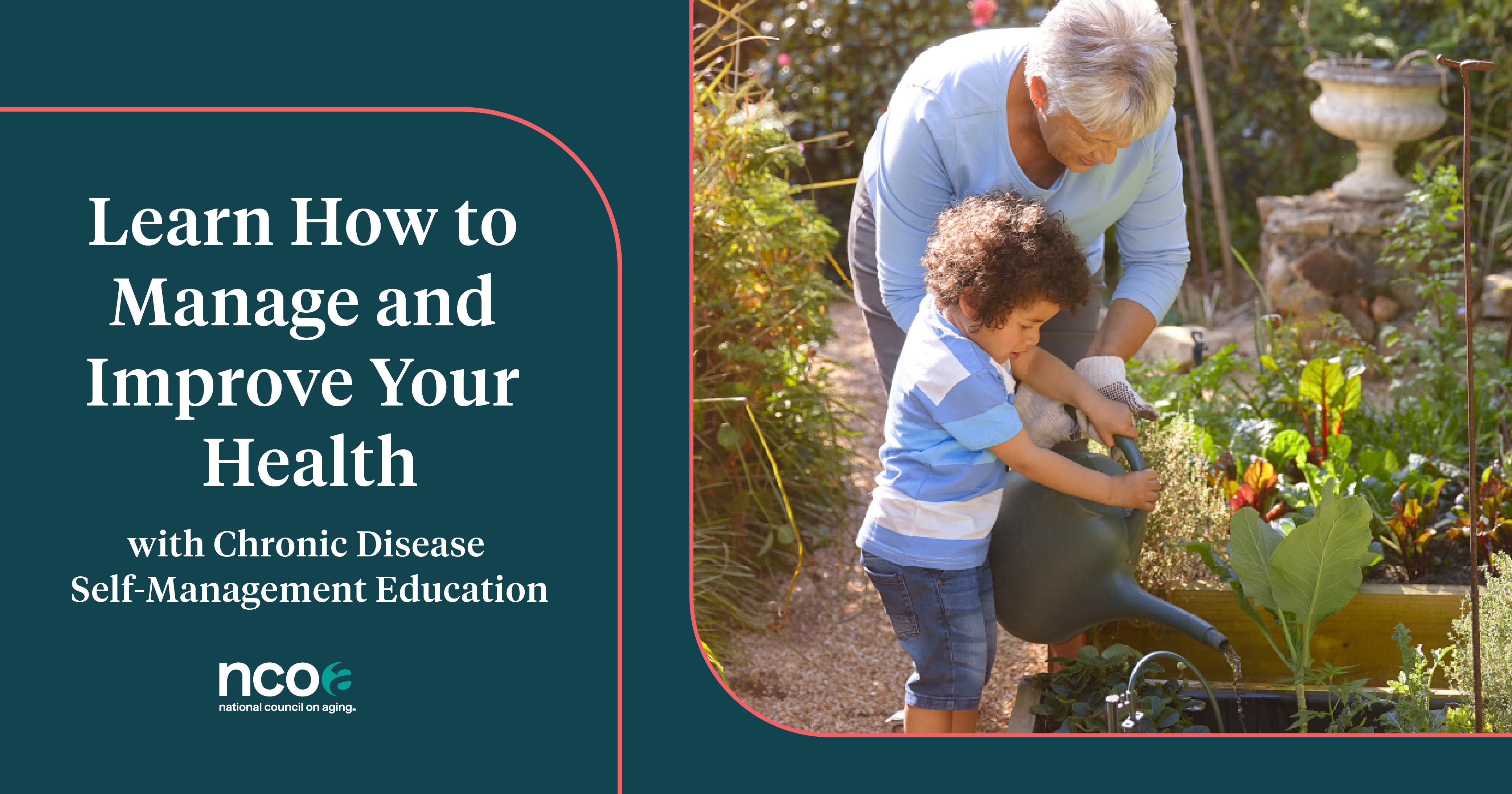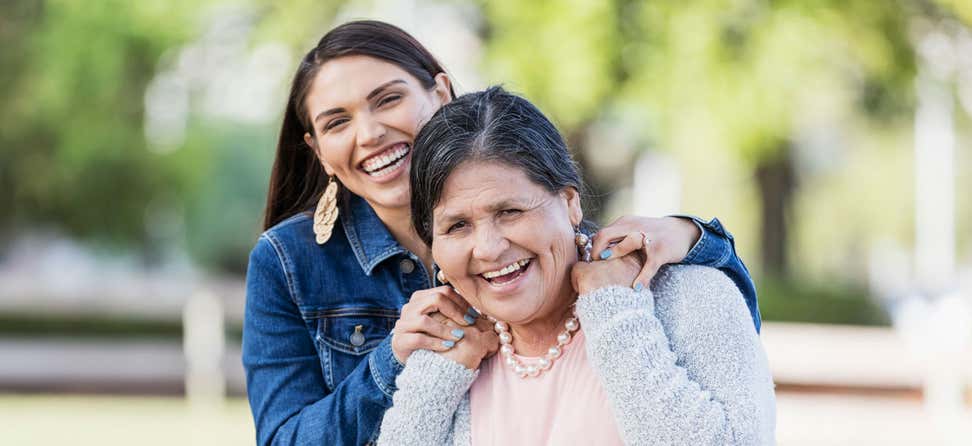Key Takeaways
Chronic Disease Self-Management Education (CDSME) can help older adults better manage their chronic conditions, improve their quality of life, and lower health care costs.
NCOA leads the National CDSME Resource Center, which raises awareness about the impact of chronic conditions on older adults and supports the implementation of evidence-based health promotion programs across the nation.
Use NCOA's social media toolkit below to help your organization recruit more older adults to your evidence-based CDSME programs.
Eighty percent of adults 65 and older have at least one chronic condition, while 68% have two or more. Chronic Disease Self-Management Education (CDSME) can help older adults better manage chronic conditions such as diabetes, heart disease, arthritis, chronic pain, and depression.
CDSME participants learn skills to manage their conditions on a day to day basis through exercise, healthy eating, symptom management, weight loss, and communication skills—all in six weeks.
Evidence-Based Chronic Disease Self-Management Education Programs Social Media Toolkit
You can help your community understand and manage chronic conditions by recruiting older adults to your evidence-based CDSME programs through social media. Use the resources, tools, and digital assets below on the platforms your organization uses.
Messaging and video assets to use on your social media platforms
| Video 1: Take Control of Your Chronic Health Conditions | |
| Social Media Platform | Sample Messaging Copy to Use |
| Facebook and Instagram |
When talking about her knee replacements, Marian Oser, a volunteer at Brightview Senior Living, says she was left with #ChronicPain in both of her knees that greatly limited her mobility. "I could've ended up sitting in my living room for most of the time and feeling terribly isolated," Oser said. Instead, she chose the path of Chronic Disease Self-Management Education (CDSME). Both in-person and online, #CDSME programs empower #OlderAdults with chronic diseases to manage their own care and improve their quality of life. Find out how CDSME programs can be transformational in a period of just six weeks. Watch this video created by the National Council on Aging 🎥👇 https://bit.ly/Take-Control-of-Your-Chronic-Health-Conditions |
|
"Over half of #OlderAdults have two or more ongoing health conditions, like #ChronicPain, #Diabetes, or high #BloodPressure," says NCOA's Kathleen Cameron. Managing these #ChronicConditions can feel overwhelming, but Cameron says older adults can call the shots through Chronic Disease Self-Management Education (CDSME). Find out how CDSME programs can be transformational in a period of just six weeks. Watch the video below. 🎥👇 https://bit.ly/Take-Control-of-Your-Chronic-Health-Conditions |
|
|
Managing #ChronicConditions can feel overwhelming, but NCOA's @KCameronNCOA says #OlderAdults can call the shots through Chronic Disease Self-Management Education (CDSME). See how they can be transformational in just six weeks. Watch the video. 🎥👇 |
|
| Link to video 1 on YouTube | |
|
Embed code to place on your website: <iframe width="560" height="315" src="https://www.youtube.com/embed/5ft4R9H2Aks" title="YouTube video player" frameborder="0" allow="accelerometer; autoplay; clipboard-write; encrypted-media; gyroscope; picture-in-picture; web-share" allowfullscreen></iframe> |
|
| Video 2: How Evidence-Based CDSME Programs Gave Marian Her Life Back | |
| Social Media Platform | Sample Messaging Copy to Use |
| Facebook and Instagram |
Getting out and involved in a six-week course to help manage her #ChronicConditions gave Marian Oser, a volunteer at Brightview Senior Living, a new lease on life. Both in-person and online, Chronic Disease Self-Management Education (#CDSME) programs empower #OlderAdults with chronic diseases to manage their own care and improve their quality of life. Watch Marian's story in this video created by the National Council on Aging 🎥👇 |
|
Both in-person and online, Chronic Disease Self-Management Education (CDSME) programs empower #OlderAdults with chronic diseases to manage their own care and improve their quality of life. For Marian Oser, a volunteer at Brightview Senior Living, her six-week course gave her a new lease on life. Watch her story in this video created by the National Council on Aging 🎥👇 |
|
|
For Marian Oser, a volunteer at Brightview Senior Living, her six-week Chronic Disease Self-Management Education course gave her a new lease on life. Watch her story in this video created by the National Council on Aging 🎥👇 |
|
| Link to video 2 on YouTube | |
|
Embed code to place on your website: <iframe width="560" height="315" src="https://www.youtube.com/embed/SYBLquzE0oA" title="YouTube video player" frameborder="0" allow="accelerometer; autoplay; clipboard-write; encrypted-media; gyroscope; picture-in-picture; web-share" allowfullscreen></iframe> |
|
Static images to use with sample CDSME social media messaging above
In addition to using the video assets that NCOA has created, you can also use the following static images for Facebook and Instagram. Just grab the sample messages above and post the copy with one of the following images.

for Facebook: Learn How to Manage and Improve Your Health with CDSME
- Static image option 1 (as pictured above)
- Static image option 2 (two Caucasian older adult women floating in a pool smiling)
- Static image option 3 (older adult man with baseball cap on is out in nature walking his dog)
for Instagram: Learn How to Manage and Improve Your Health with CDSME
- Static image option 1 (as pictured above)
- Static image option 2 (two Caucasian older adult women floating in a pool smiling)
- Static image option 3 (older adult man with baseball cap on is out in nature walking his dog)
Key facts about chronic diseases that can be used in messaging
- Older adults are disproportionately affected by chronic conditions, such as diabetes, arthritis, and heart disease.
- Nearly 95% percent have at least one chronic condition, and nearly 80% of have two or more.1
- Chronic diseases can limit a person’s ability to perform daily activities, cause them to lose their independence, and result in the need for institutional care, in-home caregivers, or other long-term services and supports.2
- Chronic diseases are the leading drivers of increasing the nation’s health care costs of $4.1 trillion annually.3
- Chronic pain and diabetes are the most expensive chronic conditions with annual spending totaling $635 billion4 and $327 billion5, respectively.
This project was supported, in part by grant number 90CSSG0048 and 90FPSG0051 from the U.S. Administration for Community Living, Department of Health and Human Services, Washington, D.C. 20201. Grantees undertaking projects under government sponsorship are encouraged to express freely their findings and conclusions. Points of view or opinions do not, therefore, necessarily represent official Administration for Community Living policy.
Sources
1. National Council on Aging. Chronic Inequities: Measuring Disease Cost Burden Among Older Adults in the U.S. A Health and Retirement Study Analysis. Page 5, Figure 2. April 2022. Found on the internet at https://ncoa.org/article/the-inequities-in-the-cost-of-chronic-disease-why-it-matters-for-older-adults
2. Centers for Disease Control and Prevention. The State of Aging and Health in America 2013. Atlanta, GA: Centers for Disease Control and Prevention, US Dept of Health and Human Services; 2013.
3. Centers for Disease Control and Prevention. Health and Economic Costs of Chronic Diseases. Found on the internet at https://www.cdc.gov/chronicdisease/about/costs/index.htm.
4. Smith, Thomas J., Hillner, Bruce E. The Cost of Pain. Health Policy; 2019.
5. Centers for Disease Control and Prevention. Health and Economic Costs of Chronic Diseases. Found on the internet at https://www.cdc.gov/chronicdisease/about/costs/index.htm.












